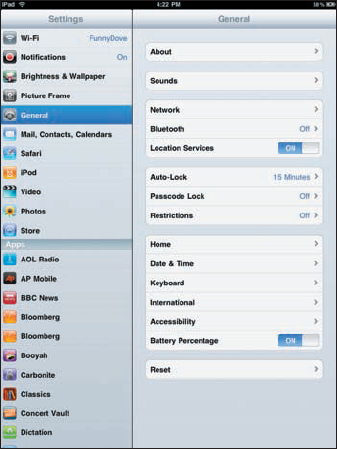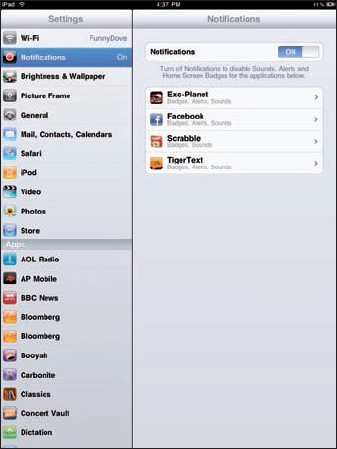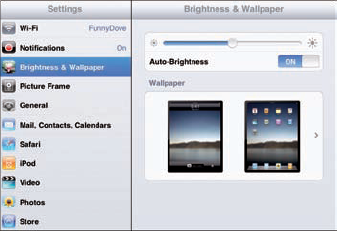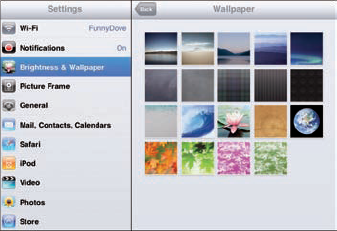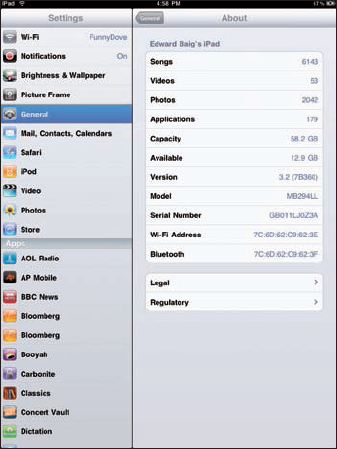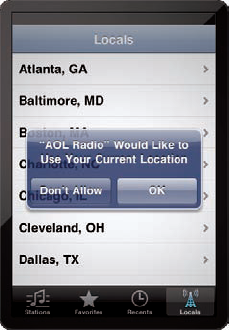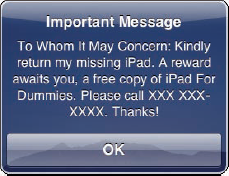In This Chapter
Taking off in airplane mode
Preparing networks
Uncovering usage statistics
Seeking sensible sounds and screen brightness
Brushing up on Bluetooth
Finding a lost iPad
Do you consider yourself a control freak? The type of person who has to have it your way? Boy, have you landed in the right chapter.
Settings is kind of the makeover factory for the iPad. You open Settings by tapping its Home screen icon, and from there, you can do things like change the tablet's background or wallpaper and specify Google or Yahoo! as the search engine of choice. You can also alter security settings in Safari, tailor e-mail to your liking (among other modifications), and get a handle on how to fetch or push new data.
Tip
The Settings area on the iPad is roughly analogous to the Control Panel in Windows and System Preferences on a Mac.

Because we cover some settings elsewhere in this book, we don't dwell on every setting here. But you still have plenty to discover to help you make the iPad your own.
When you first open Settings, you'll see a display that looks something like Figure 13-1, with a scrollable list on the left side of the screen and a panel on the right that corresponds to whichever setting is highlighted in blue. We say "something like this" because the Settings on your iPad may differ slightly from those of your neighbor's.
One other general thought to keep in mind: If you see a greater-than symbol (>) appear to the right of a listing, it is telling you that the listing has a bunch of options. Throughout this chapter, you tap the > symbol to check out those options.
As you scroll to the bottom of the list on the left, you come to all the settings that pertain to some of the specific third-party apps you've added to the iPad (see Chapter 7). Everybody has a different collection of apps on his or her iPad, so any settings related to those programs will also obviously be different.
Your iPad offers settings to keep you on the good side of air-traffic communications systems. However, the settings for the iPad Wi-Fi + 3G model differ from those of the Wi-Fi-only model. The former includes a setting called Airplane Mode (covered in the next section) that the latter doesn't have.
As we mentioned, you see the Airplane Mode setting only if you have the iPad with 3G cellular access. Using a cellular radio on an airplane is a no-no. But there's nothing verboten about using an iPad on a plane to listen to music, watch videos, and peek at pictures — at least, after the craft has reached cruising altitude.
So how do you take advantage of the iPad's built-in iPod (among other capabilities) at 30,000 feet, while temporarily turning off your wireless gateway to e-mail and Internet functions? The answer is, by turning on Airplane mode.
To do so, merely tap Airplane Mode on the Settings screen to display On (rather than Off).
That act disables each of the iPad's wireless radios: Wi-Fi, EDGE, 3G, and Bluetooth. While your iPad is in Airplane mode, you can't surf the Web, get a map location, send or receive e-mails, stream YouTube, sync contacts, use iTunes or the App Store, or do anything else that requires an Internet connection. If there's a silver lining here, it's that the iPad's long-lasting battery ought to last even longer — good news if the flight you're on is taking you halfway around the planet.
Tip
If you plug the iPad into an iPod accessory that isn't necessarily compatible because of possible interference from the iPad's wireless radios, it offers to turn on Airplane mode for you.
If you have the Wi-Fi only model, you have to manually turn off Wi-Fi here in Settings before your flight takes off, as discussed in the next section.
As we mention in Chapter 4, Wi-Fi is typically the fastest wireless network you can use to surf the Web, send e-mail, and perform other Internet tricks on the iPad. You use the Wi-Fi setting to determine which Wi-Fi networks are available to you and which one to exploit based on its signal.
Tap Wi-Fi so that the setting is on and all Wi-Fi networks in range are displayed, as shown in Figure 13-2. (Alternatively, you can reach this screen by tapping the General setting, tapping Network, and then tapping Wi-Fi.)
Tap the Wi-Fi switch to off when you're on a plane or don't have access to a network and don't want to drain the battery.
A signal-strength indicator can help you choose the network to connect to if more than one is listed; tap the appropriate Wi-Fi network when you reach a decision. If a network is password-protected, you see a Lock icon.
You can also turn the Ask to Join Networks setting on or off. Networks that the iPad are already familiar with are joined automatically, regardless of which one you choose. If the Ask feature is off and no known networks are available, you have to manually select a new network. If the Ask feature is on, you're asked before joining a new network. Either way, you see a list with the same Wi-Fi networks in range.
Tip
If you used a particular network automatically in the past but you no longer want your iPad to join it, tap the > symbol next to the network in question (within Wi-Fi settings) and then tap Forget This Network. The iPad develops a quick case of selective amnesia.
Note
In some instances, you have to supply other technical information about a network you hope to glom on to. You encounter a bunch of nasty-sounding terms: DHCP, BootP, Static, IP Address, Subnet Mask, Router, DNS, Search Domains, client ID, HTTP Proxy, and Renew Lease. (At least this last one has nothing to do with renting an apartment or the vehicle you're driving.) Chances are that none of this info is on the tip of your tongue — but that's okay. For one thing, it's a good bet that you'll never need to know this stuff. What's more, even if you do have to fill in or adjust these settings, a network administrator or techie friend can probably help you out.
Sometimes, you may want to connect to a network that's closed and not shown on the Wi-Fi list. If that's the case, tap Other and use the keyboard to enter the network name. Then tap to choose the type of security setting the network is using (if any). Your choices are WEP, WPA, WPA2, WPA Enterprise, and WPA2 Enterprise. Again, it's not exactly the friendliest terminology in the world, but we figure that someone nearby can lend a hand.
Note
If no Wi-Fi network is available, you have to rely on 3G or EDGE if you have the Wi-Fi + 3G model. If you don't or you're out of reach of a cellular network, you can't rocket into cyberspace until you regain access to a network.
You see another set of settings only if you have the Wi-Fi + 3G iPad. Your options here are as follows:
Data Roaming: You may unwittingly rack up lofty roaming fees when exchanging e-mail, surfing Safari, or engaging in other data-heavy activities while traveling abroad. Turn Data Roaming off to avoid such potential charges.
Tip
Cellular Data Network: If you know you don't need the cellular network when you're out and about or are in an area where you don't have access to the network, turn it off. Your battery will thank you later.
Account Information: Tap View Account to see or edit your account information.
Add a SIM PIN: The tiny SIM, or Subscriber Identity Module, card inside your iPad holds important data about your account. To add a PIN or passcode to lock your SIM card, tap SIM PIN. That way, if someone gets hold of your SIM, he or she can't use it in another iPad without the passcode.
Note
If you assign a PIN to your SIM, you have to enter it to turn the iPad on or off, which some of you might consider a minor hassle.
Through Apple's "Push Notification" service, app developers can send you alerts related to programs you've installed on your iPad. Such alerts are typically in text form but may include sounds as well. The idea is that you'll receive notifications even when the application they apply to isn't running. Notifications may also appear as numbered "badges" on their corresponding Home screen icon.
The downside to keeping notifications turned on is that they can curtail battery life. And some of you may find notifications distracting at times.
To turn off all the notifications on your iPad, tap Notifications on the left side of the Settings screen and then tap the Notifications button shown in Figure 13-3 so that Off is showing. To turn them back on, tap the Off button so that it turns blue and now shows as an On button. Simple as that.
Tip
You can turn notifications on or off for specific apps, too, and you have two ways to accomplish this feat. We recommend trying both methods because different notifications are controlled in each example:
Method 1: Tap to highlight Notifications on the left side of the screen and then tap an app on the right, shown in Figure 13-3. Within that specific app, you can turn sounds, alerts, or badges on or off.
Method 2: Scroll down to the Apps section on the left side of Settings and tap the app with the notifications you want to alter. Note that the app you hope to fiddle with doesn't always appear in the Apps section of Settings. For that matter, many of the apps that do appear on the list do not push notifications to you anyway.
One app that does have a variety of notifications is Facebook. You can choose to be notified about Wall Posts, Friend Requests, Photo Tags, and more. Or, choose not to be notified about any or all of these. You can only tweak such settings under Method 2, because Method 1 lets you alter only sounds, alerts, or badges.
Note
As this book went to press, the iPad couldn't handle third-party multitasking, meaning the ability to run some apps in the background while you're doing something else. For example, to listen to music on Pandora Internet Radio, you would have to open Pandora to listen. If you then wanted to surf the Web, you'd have to close Pandora and fire up Safari. That's when the music dies.
In April 2010, Apple announced that third-party multitasking would be coming to the iPad later in the year, all part of the iPhone OS 4.0 operating system. It remains to be seen exactly how third-party multitasking will work, but we wanted to let you know that while you may not have it on your iPad just yet, multitasking is on its way.
The next bunch of settings control what the iPad looks like and sounds like.
Who doesn't want a bright, vibrant screen? Alas, the brightest screens exact a trade-off: Before you drag the brightness slider shown in Figure 13-4 to the max, remember that brighter screens sap the life from your battery more quickly. The control appears when Brightness & Wallpaper is highlighted.
Choosing wallpaper is a neat way to dress up the iPad according to your aesthetic preferences. You can sample the pretty patterns and designs that the iPad has already chosen for you as follows:
Tap the thumbnails shown when you highlight the Brightness & Wallpaper setting. (Refer to Figure 13-4.)
Choose an image.
You can choose a favorite picture from your photo albums or select one of the gorgeous images that Apple has supplied, as shown in Figure 13-5.
Tap one of the following options to set where your wallpaper appears:
Set Lock Screen makes your selected image the wallpaper of choice when the iPad is locked.
Set Home Screen makes the wallpaper decorate only your Home screen.
Set Both makes your image the wallpaper for locked and Home screens.
From Settings, you can also turn your iPad into an animated picture frame. Refer to Chapter 10 for more on the Picture Frame feature and the settings to get it just the way you like it.
Consider the Sounds settings area, found after you highlight General in the Settings list to the left, the iPad's soundstage. There, you can turn audio alerts on or off for a variety of functions: new e-mail, sent mail, and calendar alerts. You can also decide whether you want to hear lock sounds and keyboard clicks.
To raise the decibel level of alerts, drag the volume slider to the right. Drag in the opposite direction to bring down the noise.
An alternative way to adjust sounds (as the iPad so often offers alternatives): You can use the physical Volume buttons on the side of the iPad for this purpose, as long as you're not already using the iPad's iPod to listen to music or watch video.
Certain miscellaneous settings are difficult to pigeonhole. Apple wisely lumped these under the General settings moniker. Here's a closer look.
You aren't seeing double. This section, shown in Figure 13-6, is all about the setting known as About. And About is full of trivial (and not-so-trivial) information about the device. What you find here is straightforward:
Number of songs stored on the device
Number of videos
Number of photos
Number of applications
Storage capacity used and available: Because of the way the device is formatted, you always have a little less storage than the advertised amount of flash memory.
Software version: We were up to version 3.2 as this book was being published. But as the software is tweaked and updated, your device takes on a new "build" identifier indicating it's just a little bit further along than some previous build. So you see, in parentheses next to the version number, a string of numbers and letters that looks like 7B360. That tells you more precisely what software version you have. It changes whenever the iPad's software is updated.
Carrier and cellular data (Wi-Fi + 3G version only): Yep, that's AT&T in the United States.
Wi-Fi address
Bluetooth address: More on Bluetooth in an upcoming section.
Legal and Regulatory: You had to know that the lawyers would get their two cents in somehow. All the fine print is here. And fine print it is, though you can unpinch the legal (but not regulatory) notice to enlarge the text. (Not that we can imagine more than a handful of you will bother to read this legal mumbo jumbo.)
The About setting we just covered gives a lot of information about your device. But after you back out of About and return to the main General settings, you can find other settings for statistics on iPad usage:
Battery percentage: You always see a little battery meter in the upper-right corner of the screen. If you also want to see your battery life presented in percentage terms, make sure that the Battery Percentage setting is turned on.
Cellular network data: The amount of network data you sent and received over EDGE or 3G, a setting that only applies (and shows up) if you have the Wi-Fi + 3G iPad. You can reset these statistics by tapping the Reset Statistics button. If you choose to pay for only 250MB per month, this is where you can check whether you're close to your data limit.
After you tap Network on the General settings screen, you see two controls: Wi-Fi and VPN. We addressed Wi-Fi earlier in this chapter, in the section "Controlling Wi-Fi Connections," and in Chapter 10. VPN is tackled here.
Note
A virtual private network, or VPN, is a way for you to securely access your company's network behind the firewall — using an encrypted Internet connection that acts as a secure "tunnel" for data.
You can configure a VPN on the iPad by following these steps:
Tap Settings

Tap one of the protocol options.
The iPad software supports the protocols L2TP (Layer 2 Tunneling Protocol), PPTP (Point-To-Point Tunneling Protocol), and Cisco IPSec VPN, which apparently provides the kind of security that satisfies network administrators.
Using configuration settings provided by your company, fill in the appropriate server information, account, password, and other information.
Choose whether to turn on RSA SecurID authentication.
Better yet, lend your iPad to the techies at the place you work and let them fill in the blanks on your behalf.
After you configure your iPad for VPN usage, you can turn that capability on or off by tapping (yep) the VPN On or Off switch inside Settings.
Of all the peculiar terms you may encounter in techdom, Bluetooth is one of our favorites. The name is derived from a tenth century Danish monarch named Harald Blåtand, who, the story goes, helped unite warring factions. And, we're told, Blåtand translates to Bluetooth in English. (Bluetooth is all about collaboration between different types of devices — get it?)
Blåtand was obviously ahead of his time. Although we can't imagine that he ever used a slate computer, he now has an entire short-range wireless technology named in his honor. On the iPad, you can use Bluetooth to communicate wirelessly with a compatible Bluetooth headset or to use an optional wireless keyboard. Such accessories are made by Apple and many others. To ensure that the iPad works with one of these devices, it has to be wirelessly paired, or coupled, with the chosen device. If you're using a third-party accessory, follow the instructions that came with that headset or keyboard so that it becomes discoverable, or ready to be paired with your iPad. Then turn on Bluetooth (under General on the Settings screen) so that the iPad can find such nearby devices and the device can find the iPad. In Figure 13-7, an Apple Wireless Keyboard and the iPad are successfully paired when you enter a designated passkey on the keyboard. Bluetooth works up to a range of about 30 feet.
To unpair a device, select it from the device list, and tap Unpair. We guess breaking up isn't hard to do.
The iPad supports stereo Bluetooth headphones, so you can now stream stereo audio from the iPad to those devices.
The iPad can tap into Bluetooth in other ways. One is through peer-to-peer connectivity, so you can engage in multiplayer games with other nearby iPad, iPhone, or iPod touch users. You can also do such things as exchange business cards, share pictures, and send short notes. And, you don't even have to pair the devices as you do with a headset or wireless keyboard.
Warning
You can't use Bluetooth to exchange files or sync between an iPad and a computer. Nor can you use it to print stuff from the iPad on a Bluetooth printer. That's because the iPad doesn't support any of the Bluetooth profiles (or specifications) required to allow such wireless stunts to take place — at least not as of this writing. We think that's a shame.
Location, location, location. By using Maps or any number of third-party apps, the iPad makes good use of knowing where you are. The iPad with 3G exploits built-in GPS. The Wi-Fi-only iPad can find your general whereabouts (by triangulating signals from Wi-Fi base stations and cellular towers).
If that statement creeps you out a little, don't fret. To protect your right to privacy, individual apps pop up quick messages (similar to the one shown in Figure 13-8) asking whether you want them to use your current location. But you can also turn off Location Services right there in Settings (refer to Figure 13-1). Not only is your privacy shielded, but you also keep your iPad battery juiced a little longer.
Tap Auto-Lock in the General settings pane, and you can set the amount of time that elapses before the iPad automatically locks or turns off the display. Your choices are 15 minutes before, 10 minutes, 5 minutes, or 2 minutes. Or, you can set it so that the iPad never locks automatically.
Tip
If you work for a company that insists on a passcode (see the next section), the Never Auto-Lock option isn't on the list that your iPad shows you.
Don't worry if the iPad is locked. You can still receive notification alerts and adjust the volume.
You can choose a passcode to prevent people from unlocking the iPad. Tap Passcode Lock. Then use the virtual keypad to enter a 4-digit code. During this setup, you have to enter the code a second time before it's accepted.
You can also determine whether a passcode is required immediately, after 1 minute, after 5 minutes, or after 15 minutes. Shorter times are more secure, of course. On the topic of security, the iPad can be set to automatically erase your data if someone makes ten failed passcode attempts.
You can also change the passcode or turn it off later (unless your employer dictates otherwise), but you need to know the present passcode to apply any changes. If you forget the passcode, you have to restore the iPad software, as we describe in the next chapter.
Parents and bosses may love the Restrictions tools, but kids and employees usually think otherwise. You can clamp down, er, provide proper parental guidance to your children, by preventing them at least some of the time from using the Safari browser, YouTube, iTunes, or Location Services. Or, you might not let them install new apps or make purchases inside the apps you do allow. When restrictions are in place, icons for off-limit functions can no longer be seen. Tap Enable Restrictions, set or enter your passcode — you have to enter it twice if you are setting up the passcode — and tap the buttons next to each item in the Allow or Allowed Content lists that you plan to restrict. Their corresponding settings should show Off.
Moreover, parents have more controls to work with. For instance, you can allow Junior to watch a movie on the iPad but prevent him from watching a flick that carries an R or NC-17 rating. You can also restrict access to certain TV shows, explicit songs and podcasts, and apps, based on age-appropriate ratings. Stop feeling guilty: You have your users' best interests at heart.
If guilt does get the better of you, you can turn Restrictions off. Open the Restrictions setting by again typing in your passcode. Then switch the On/Off setting back to On for each setting you are freeing up. Tap Disable Restrictions. You have to enter your passcode one more time before your kids and office underlings return you to their good graces.
You can assign shortcuts to the Home button. You can arrange it so that double-clicking Home transports you to the Spotlight Search feature, which we describe in Chapter 2. Double-clicking Home can be set to launch the iPod too.
The default setting for double-clicking Home shares something in common with Dorothy of Kansas: If you don't change this setting, double-clicking the Home button brings you back to the Home screen. Why? Because there's no place like Home. (Groan.)
You can do two more things under the Home settings:
Switch the iPod Controls setting to On if you want iPod controls to appear when you double-tap the Home button while music is playing.
Tap Search Results to determine which apps show up when you do a Spotlight search.
In our neck of the woods, the time is reported as 11:32 p.m. (or whatever time it happens to be). But in some circles, it's reported as 23:32. If you prefer the latter format on the iPad's status bar, tap the 24-Hour Time setting (under Date & Time) so that it's on.
This setting is just one that you can adjust under Date & Time. You can also have the iPad set the time in your time zone.
Here's how:
Tap Set Date & Time.
You see fields for setting the time zone and the date and time.
Tap the Time Zone field.
The current time zone and virtual keyboard are shown.
Tap out the letters of the city or country whose time zone you want to enter until the one you have in mind appears. Then tap the name of that city or country.
The Time Zone field is automatically filled in for that city.
Tap the Set Date & Time field so that the time is shown. Then roll the bicycle-lock-like controls until the proper time is displayed.
Tap the date shown so that the bicycle-lock-like controls pop up for the date. Then roll the wheels for the month, day, and year until the correct date appears.
Tap the Date & Time button to return to the main Date & Time settings screen.
Under Keyboard settings, you have the following options:
Auto-Correction: When turned on, the iPad will take a stab at what it thinks you mean to type.
Auto-Capitalization: You can turn autocapitalization on or off and turn Enable Caps Lock on or off.
Auto-Capitalization, which the iPad turns on by default, means that the first letter of the first word you type after ending the preceding sentence with a period, a question mark, or an exclamation point is capitalized.
Caps Lock: If Caps Lock is enabled, all letters are uppercased LIKE THIS if you double-tap the Shift key. (The Shift key is the one with the arrow pointing up.)
Automatic period and space: You can also turn on a keyboard setting that inserts a period followed by a space when you double-tap the spacebar. The "." setting that permits this is turned on by default.
Additionally, you can choose to use an international keyboard (as we discuss in Chapter 2), which you choose from the International setting — the next setting after Keyboard in the General settings area. See the next section for details.
The iPad is sure to be an international sensation just as it is in the United States. Though overseas shipments of the iPad were delayed as we were finishing this book, Apple certainly has global ambitions with its tablet. In the International section, you can set the language you type in (by using a custom virtual keyboard), the language in which the iPad displays text, and the date, time, and telephone format for the region in question.
The Accessibility or Universal Access Features tools on your iPad are targeted at helping people with certain disabilities. The following sections explain each one in turn.
This screen reader describes aloud what's on the screen. It can read e-mail messages, Web pages, and more. With VoiceOver active, you tap an item on the screen to select it. VoiceOver places a black rectangle around it, and either speaks the name or describes an item. For example, if you tap, say, Brightness & Wallpaper, the VoiceOver voice speaks the words "Brightness & Wallpaper button." VoiceOver even lets you know when you alternately position the iPad in landscape or portrait mode or when your screen is locked or unlocked.
Within the VoiceOver setting, you have several options. For instance, if you turn on Speak Hints, VoiceOver may provide instructions on what to do next, along the lines of "double-tap to open." You can drag a Speaking Rate slider to speed up or slow down the voice. You can also determine the kind of typing feedback you get, from among characters, words, characters and words, or no feedback. Additional controls let you turn on Phonetics and Pitch Change settings.
Note
The voice you hear speaks in the language you specified in International settings, which we explain in the preceding section.
You have to learn a whole new set of finger gestures when VoiceOver is on, which may seem difficult, especially when you first start using VoiceOver. When you stop to think about it, the reason makes a lot of sense. You want to be able to hear descriptions on the screen before you actually activate buttons. Different VoiceOver gestures use different numbers of fingers. Here's a rundown on many of these:
Tap: Speaks the item.
Flick right or left: Select the next or previous item.
Flick up or down: Has multiple outcomes that depend on how you set the so-called "Rotor Control" Gesture. Think of the rotor control like you'd think about turning a dial. You rotate two fingers on the screen. The purpose is to switch to a different set of commands or features. Which leads us back to the flick up or down gestures. Say you're reading text in an e-mail. By alternately spinning the rotor, you can switch between hearing the body of a message read aloud word by word or character by character. After you set the parameters, flick up or down to hear stuff read back. The flicking up or down gestures serve a different purpose when you type an e-mail: The gestures move the cursor left or right within the text.
Two-finger tap: Stop speaking.
Two-finger flick up: Read everything from the top of the screen.
Two-finger flick down: Read everything from your current position on the screen.
Three-finger flick up or down: Scroll a page.
Three-finger flick right or left: Go to the next or previous page.
Three-finger tap: Lets you know which page or rows are on the screen.
Four-finger flick up or down: Go to the first or last part of the page.
Four-finger flick right or left: Go to the next or previous section.
Double-tap: Activates a selected icon or button to launch an app, turn a switch from On to Off, and more.
Touch an item with one finger and tap the screen with another: Otherwise known as "split-tapping," when you touch an item a voice identifies what you touched (for example "Safari button" or "Notifications on button"). A tap with the second finger selects whatever was identified with the first finger (that is, "Safari button selected," "Notifications on button selected.") Now you can double-tap to launch the button or whatever else was selected.
Double-tap, hold for a second, and then add a standard gesture: Tells the iPad to go back to using standard gestures for your next move. You can also use standard gestures with VoiceOver by double-tapping and holding the screen. You hear tones that remind you that standard gestures are now in effect. They stay that way until you lift your finger.
Two-finger double-tap: Play or pause. You'll use the double-tap in the iPod, YouTube, and Photos apps.
Three-finger double-tap: Mute or unmute the voice.
After all this you may be thinking, "Geez, that's a lot to take in." It surely is. But Apple helps you practice VoiceOver gestures by tapping a Practice VoiceOver Gestures button.
The Zoom feature offers a screen magnifier for those who are visually challenged. To zoom by 200 percent, double-tap the screen with three fingers. Drag three fingers to move around the screen. To increase magnification, use three fingers to tap and drag up. Tap with three fingers and drag down to decrease magnification.
Warning
When magnified, the characters on the screen aren't as crisp, and you can't display as much in a single view.
The colors on the iPad can be reversed to provide a higher contrast for people with poor eyesight. The screen resembles a film negative.
If you suffer hearing loss in one ear, the iPad can combine the right and left audio channels so that both can be heard in both earbuds of any headset you plug in.
Note
The iPad, unlike its cousins the iPhone or the iPod, doesn't come with earbuds or a headphones. You have to supply your own.
When this setting is on, the iPad automatically speaks autocorrections and capitalizations.
Set the Triple-Click Home feature to summon the following accessibility tools. Clicking Home three times rapidly can be used to toggle VoiceOver on or off or toggle White on Black on or off. You can also set up a prompt to be asked which of these functions you want to accomplish.
As little kids playing sports, we ended an argument by agreeing to a "do-over." Well, the Reset settings on the iPad are one big do-over. Now that we're (presumably) grown up, we're wise enough to think long and hard about the consequences before implementing do-over settings. Regardless, you may encounter good reasons for starting over; some of these are addressed in Chapter 14.
Here are your reset options:
Reset All Settings: Resets all settings, but no data or media is deleted.
Erase All Content and Settings: Resets all settings and wipes out all your data.
Reset Network Settings: Deletes the current network settings and restores them to their factory defaults.
Reset Keyboard Dictionary: Removes added words from the dictionary. Remember that the iPad keyboard is intelligent. And, one reason it's so smart is that it learns from you. So when you reject words that the iPad keyboard suggests, it figures that the words you specifically banged out ought to be added to the keyboard dictionary.
Reset Home Screen Layout: Reverts all icons to the way they were at the factory.
Reset Location Warnings: Restores factory defaults.
We hope you never have to use the Find My iPad feature — though we have to say that it's pretty darn cool. If you inadvertently leave your iPad in a taxi or restaurant, Find My iPad may just help you retrieve it. The feature requires a MobileMe subscription.
To turn on Find My iPad, tap Settings
Now suppose that you lost your tablet — and we can only assume that you're beside yourself. Follow these steps to see whether the Find My iPad feature can help you:
Log on to your MobileMe
me.comaccount from any browser on your computer.Click Find My iPhone (yes, it's called Find My iPhone, not Find My iPad at
me.com).Assuming that your tablet is turned on and in the coverage area, its general whereabouts turn up on a map, as shown in Figure 13-9. In our tests, Find My iPad found our iPads quickly.
The truth is that even seeing your iPad on a map may not help you much, especially if the device is lost somewhere in midtown Manhattan. Take heart.
Type out a plea to the Good Samaritan that you hope picked up your iPad.
The message appears on the lost iPad's screen. Don't forget to include in the message a way for the person to reach you, such as the message displayed on the iPad in Figure 13-10.
Tip
To get someone's attention, you can also sound an alarm that plays for two minutes, even if the volume is off. Hey, that alarm may come in handy if the iPad turns up under a couch in your house. Stranger things have happened.
After all this labor, if the iPad is seemingly gone for good, click Remote Wipe at the MobileMe site to delete your personal data from afar and return the iPad to its factory settings. (A somewhat less drastic measure is to remotely lock your iPad using a four-digit passcode.) And, if you ever get your iPad back, you can always restore the information from an iTunes backup on your Windows PC or Mac.

